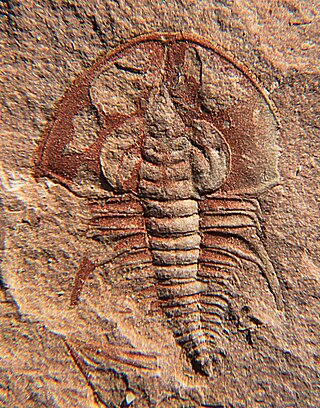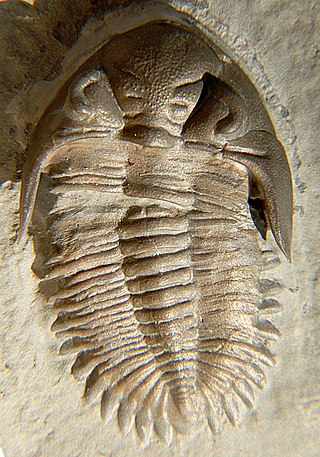
The Silurian is a geologic period and system spanning 24.6 million years from the end of the Ordovician Period, at 443.8 million years ago (Mya), to the beginning of the Devonian Period, 419.2 Mya. The Silurian is the shortest period of the Paleozoic Era. As with other geologic periods, the rock beds that define the period's start and end are well identified, but the exact dates are uncertain by a few million years. The base of the Silurian is set at a series of major Ordovician–Silurian extinction events when up to 60% of marine genera were wiped out.

Trilobites are extinct marine arthropods that form the class Trilobita. Trilobites form one of the earliest known groups of arthropods. The first appearance of trilobites in the fossil record defines the base of the Atdabanian stage of the Early Cambrian period and they flourished throughout the lower Paleozoic before slipping into a long decline, when, during the Devonian, all trilobite orders except the Proetida died out. The last trilobites disappeared in the mass extinction at the end of the Permian about 251.9 million years ago. Trilobites were among the most successful of all early animals, existing in oceans for almost 270 million years, with over 22,000 species having been described.
An evolutionary radiation is an increase in taxonomic diversity that is caused by elevated rates of speciation, that may or may not be associated with an increase in morphological disparity. A significantly large and diverse radiation within a relatively short geologic time scale is often referred to as an explosion. Radiations may affect one clade or many, and be rapid or gradual; where they are rapid, and driven by a single lineage's adaptation to their environment, they are termed adaptive radiations.

Dalmanites is a genus of trilobite in the order Phacopida. They lived from the Late Ordovician to Middle Devonian.

Olenellina is a suborder of the order Redlichiida of trilobites that occurs about halfway during the Lower Cambrian, at the start of the stage called the Atdabanian. The earliest trilobites in the fossil record are arguably Olenellina, although the earliest Redlichiina,Ptychopariida, and Eodiscina follow quickly. The suborder died out when the Lower Cambrian passed into the Middle Cambrian, at the end of the stage called Toyonian. A feature uniting the Olenellina is the lack of rupture lines in the headshield, which in other trilobites assist the periodic moulting, associated with arthropod growth. Some derived trilobites have lost facial sutures again, but all of these are blind, while all Olenellina have eyes.
Malvinella buddeae is a species of trilobite which lived in La Paz, Bolivia during the Devonian period.

Bellacartwrightia is a relatively uncommon genus of phacopid trilobite, found in the mid-Devonian Hamilton Group of New York state, mainly in strata exposed near Lake Erie just west of Buffalo. This trilobite is usually about 1.5" to 2" long. A very similar trilobite from the Devonian of Morocco is still sold as Metacanthina, but considerable research is still being done on Moroccan trilobites.

Archaeaspis is an extinct genus of redlichiid trilobites. It lived during the late Atdabanian stage, which lasted from 521 to 514 million years ago during the early part of the Cambrian Period. The first specimens were first found in Siberia, where they were originally thought to have been endemic. Later, though, more specimen were found in the Inyo Mountains in Southern California. An Ediacarian proarticulatan was given the same name, Archaeaspis Ivantsov, 2001. This is however a junior homonym. The name Archaeaspis Repina in Khomentovskii and Repina, 1965, for the trilobite has priority. The new valid name for the proarticulate is Archaeaspinus Ivantsov, 2007.

Callavia is an extinct, monotypic genus of trilobite arthropods. C. broegeri lived during the late Atdabanian stage, which lasted from 530 to 524 million years ago during the early part of the Cambrian Period in what are today Canada and the United States.

Nevadella is an extinct genus of trilobites, fossil marine arthropods, with species of average size. It lived during the late Atdabanian stage, which lasted from 530 to 524 million years ago during the early part of the Cambrian Period.
Fallotaspidella is an extinct genus of redlichiid trilobites. It lived during the late Atdabanian stage, which lasted from 530 to 524 million years ago during the early part of the Cambrian Period.
The Cambrian explosion is an interval of time approximately 538.8 million years ago in the Cambrian period of the early Paleozoic when there was a sudden radiation of complex life, and practically all major animal phyla started appearing in the fossil record. It lasted for about 13 to 25 million years and resulted in the divergence of most modern metazoan phyla. The event was accompanied by major diversification in other groups of organisms as well.

Nephrolenellus is an extinct genus of trilobite, fossil marine arthropods, of relatively small size. Currently two species are attributed to it. Nephrolenellus lived at the end of the Lower Cambrian. Species are known from the Great Basin of California, Nevada and Arizona, with one specimen from Canada.

The Marjum Formation is a Cambrian geological formation that overlies the Wheeler Shale in the House Range, Utah. It is named after its type locality, Marjum Pass, and was defined in 1908. The formation is known for its occasional preservation of soft-bodied tissue, and is slightly younger than the Burgess Shale, falling in the Ptychagnostus praecurrens trilobite zone.

The Biceratopsinae is an extinct subfamily of redlichiid trilobites within the family Biceratopsidae, with species of small to average size. Species belonging to this subfamily lived during the Toyonian stage, 516-513 million years ago, in the former continent of Laurentia, including what are today the South-Western United States and Canada.

The Olenelloidea are a superfamily of trilobites, a group of extinct marine arthropods. They lived during the late Lower Cambrian and species occurred on all paleocontinents.
Bouleia is a genus of trilobites in the order Phacopida which existed during the lower Devonian in what is now Bolivia. It was described by Kozlowski in 1923, and the type species is B. dagincourti, which was originally described under the genus Phacops by Ulrich in 1892. It also contains the species B. sphaericeps, originally described by Kozlowski, also in 1923, as Dereimsia sphaericeps. The type locality was the Icla Formation in Padilla.

Hollardops is a genus of trilobite in the order Phacopida that lived during the Devonian. Their fossils are found in the upper Emsian of western Europe and in the lower Emsian to lowermost Eifelian of North Africa. The type species, Asteropyge mesocristata, was described from Algeria by Le Maître in 1952. The genus Hollardops was erected by Morzadec in 1997. In the same year, Lieberman & Kloc erected Modellops and Philipsmithiana but those genera are regarded as subjective synonyms of Hollardops. The 10-segmented thoracic condition of Hollardops is a rare feature among acastid trilobites that almost always have 11 thorax segments. Van Viersen & Kloc (2022) revisited Hollardops and described a number of new species from the Devonian of Morocco. They also regarded Pennarbedops Bignon & Crônier, 2013 as a synonym of Hollardops. Van Viersen & Kloc construed Hollardops as a scavenger or predator with well-developed eyes, that used its shovel-like cephalon to plough the top layers of the sediment in search of food. Hollardops had small pits horizontally along the fringe of the exoskeleton; these are believed to have housed setae that allowed the trilobite to closely monitor its surroundings.
The sloshing bucket model of evolution is a theory in evolutionary biology that describes how environmental disturbances varying in magnitude will affect the species present. The theory emphasizes the causal relationship between environmental factors that impinge and affect genealogical systems, providing an overarching view that determines the relationship between the variety of biological systems.
Tolkienia is an extinct genus of trilobite in the family Acastidae. It consists of three species split from Comura based on morphological differences. The genus was present during the Emsian stage of the Early Devonian epoch around 400 Ma.













